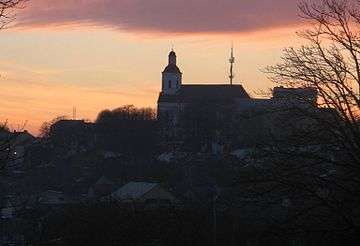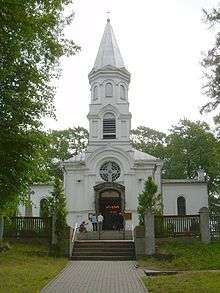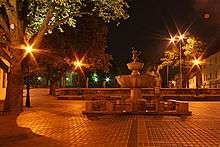Telšiai
Telšiai is a city in Lithuania, the capital of Telšiai County and Žemaitija region, and the 12th largest city in the country (29,000 inhabitants). It is built on seven hills and encompasses northern part of Lake Mastis.
Understand

The city was named after a small rivulet, Telšė which flows into the Lake Mastis. A legend has it that a Knight named Džiugas founded the city. Telšiai was first mentioned in written sources around 1450. During the November Uprising in 1831 Telšiai became a sanctuary for Polish–Lithuanian partisans fighting the Russians.
During the years of Lithuanian independence, 1918 to 1940, Telšiai grew rapidly. Several girls' and boys' high schools, a crafts school and a teacher's seminary were founded. The Alka museum was built, and several cultural societies were operated.
During the first Soviet occupation, as a result of the Molotov–Ribbentrop Pact, Telšiai became infamous for the nearby Rainiai massacre, the mass murder of 76 Lithuanian political prisoners perpetrated by the Red Army during the night of June 24–25, 1941.
Present day architectural monuments include Telšiai Cathedral. Telšiai has a rare, surviving wooden synagogue.
- Samogitia Tourism Information Center, Turgaus a. 21, ☎ +370 444 53010.
Get in
Get around
Telšiai is small enough to be covered by foot.
See


- Žemaičių muziejaus „Alka“, Muziejaus St. 31, ☎ +370 444 70282, e-mail: info@muziejusalka.lt. Tu-Sa 09:00-17:00, Su 10:00-17:00. The museum contains collections of archaeological finds, numismatics, exhibits related to history and nature of the Žemaitija area and fine art.
- Old Town of Telšiai. The beautiful Old Town of Telšiai represents an urban monument. The town boasts a church in the late Baroque-Classicism style of the 18th century (Telšiai Cathedral since 1926) standing on the highest hill of the town.
- Turgaus square. A square in the middle of the old town. Here you can find a tower with a clock, a sculpture of the bear (Symbol of Samogitia and Telšiai), and a fountain that alludes to the Telšė river. You will also see the unique sculpture dedicated to Lithuanian Hound. If you like, you can play a rolling-ball game of Telšiai.
- Nepriklausomybės square. All national festivals and official events take place here. Check the monument commemorating guerrillas of Telšiai who fought for the Independence of Lithuania.
- Cathedral of St. Anthony of Padua, Katedros a. 2. The original side altars and the pulpit of local master J. Mažeika make this house of prayer different from other Lithuanian churches. The base of the hill of the church contains some metal and stone artwork, where texts in Samogitian can be found. The square at the gates of the churchyard contains more artwork and the fountain, dedicated to Kazimieras Simonavičius - famous engineer, the "father of the rocket" and the author of "Artis Magnae Artilleriae".
- Telšiai Bishop Vincentas Borisevičius Priest Seminary. Seminary is located in the old building of Bernadine's monks and in a new building that was constructed in 1928. Both buildings are still in use. The top floor of the new building offers a good panorama of the city.
- Church of the Assumption, Šviesos st. 2. Built in 1935, it has three altars. You can also find old paintings inside.
- Ortodox Church of St. Nicolaus, Žalgirio st. 8. Built in 1937, it is the only one example of cubism architecture in Lithuania. The church altar dates back to the middle of 19th century. Books, icons, crosses, and other sacral items are likewise older than the church.
- A. Jonušo Samogitian-Japanese-Chinese Homestead-Museum, Muziejaus st. 88, ☎ +370 674 19308. A small private museum created by Samogitian jeweller - artist A. Jonušas. Interested visitors will probably enjoy a model of Horiuji pagoda temple, also a copy of the No theatre Okame mask, scenic images of kabuki, etc.
- The First School of Telšiai Town, Kalno st. 1/Katedros a. 3. This building from 1798 hosted the first school of Telšiai. After its students took active part in the Uprising of 1831, the school was closed by the tsarist administration in 1832. The building was used as a school again in the independence period between World Wars I and II. Check a gorgeous fountain in front of the school building.
Do
- Lake Mastis. Walk around the shores of the lake.
- Žemaitė Drama theater, Respublikos st. 18, ☎ +370 444 74340.
- Germantas lake (some km northwest of the town). If you feel like taking a dip in the lake, consider this one. It is favored by locals. The water in Mastis lake (the one in the town) is not clean.
Buy
Eat
- Senamiestis, Turgaus a. 11 (in the center of town), ☎ +370 444 74744. Cafe (offering full menu, not just coffee) with nice interior and "a corner" for kids. There are photos on the walls of old-times Telšiai.
Drink
Sleep
- Telšių viešbutis hotel, Kęstučio g. 21 (in the center of the town), ☎ +370 444 53292. Check-out: 12:00. Double €23.
Connect
Go next
- Vilnius, the capital and the largest city of Lithuania.
- Riga (Ryga) in nearby Latvia.
- Klaipeda, Lithuanias third largest city is to the south west.
- Kaunas, Lithuania's second city is to the south east.
- Plungė, small city of Samogitia region with a famous manor.